MY TRAVEL JOURNAL ENTRY READS, ‘“Here niño, niño, niño,’ the divemaster calls out as he slaps the surface of the water. Apparently, this is how one calls a crocodile. I slide into the water as quietly as I can, while thinking of all the technology necessary to allow us humans to survive in the underwater world and how truly out of our element we are beneath the surface. I scan the surrounding seagrass bed for a creature that has been living in harmony with water since the days of dinosaurs. The trepidation and excitement of being up close to an American crocodile is palpable. It is not every day that one comes face to face with a living fossil. As I cautiously make my first approach, the crocodile glances in my direction and then lazily shut its eyes, as if already bored with my presence. As I draw closer, its eyes open once again — just enough time for me to capture a few tight portrait shots before it slowly rises to the surface for a breath of air and a scan of its surroundings.”
These crocodile interactions were clearly one of the highlights of my trip, but with so many extraordinary encounters awaiting divers who visit Cuba, it would be hard to rank them.
Welcome to the Garden
The Gardens of the Queen National Park — Jardines de la Reina — was established as a marine protected area (MPA) in 1996 and is one of the largest marine parks in the Caribbean. Consisting of over 250 coral and mangrove islands, the park stretches across 75 miles of the Caribbean Sea and is situated 50 miles (80 km) south of mainland Cuba. Catch and release sport fishing is allowed within the 386 square mile (1,000 km2) fishery reserve but, with the exception of lobsters, the area is a complete no-take zone. Additionally, visitation is limited to a mere 1,500 visitors (fishermen and divers) per year. Birds, iguanas, hermit crabs and Hutia — a rather large rodent that nests in trees and is affectionately called a tree rat — live here. The park is part of the Cuban National System of Protected Areas and is managed as an area of special care for special use.
As part of the permitting that allowed us access to Cuba, we were required to participate in educational exchanges with local scientists and researchers. We learned that conservation and the environment are viewed in a very positive light in Cuba. The government requires environmental permits for all businesses: they are reviewed annually and may also be revoked. Science directs politics in establishing policy and also aids in the creation of a National Environmental strategy, which is improved upon every five years, based on analysis of the success and failure of the previous plan. Each new design focuses on reforestation, the reduction of pollution both on land and in the sea and the protection of biodiversity. Several of the scientists we spoke with also emphasized the importance of collaboration between the U.S. and Cuba on environmental issues. One even went so far as to declare the environment as a National Security issue.
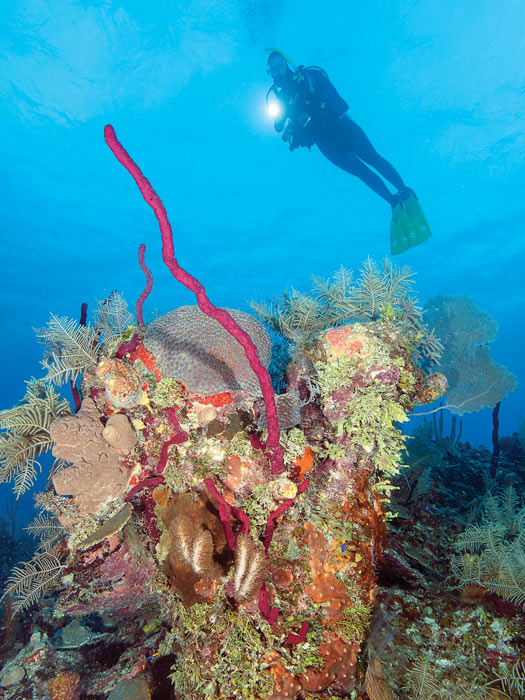
Cuba’s coral reefs are among the healthiest in the Caribbean. Photo by Matthew Meier.
Historical Background
Christopher Columbus sailed into the Jardines de la Reina in 1492 and named the area for his Queen Isabel. Cuba spent the next several centuries as a Spanish Colony. During that time, large numbers of African slaves were brought over to work the sugar and coffee plantations, both of which remain major crops to this day. Cubans overthrew Spanish Rule following the Spanish-American War of 1898 and the Treaty of Paris established Cuban independence from the U.S. in 1902. Several governments ensued before Fidel Castro led a rebel army and took control of the country in 1959. He ruled his socialist regime for nearly five decades before stepping down as president in February 2008 and handing the country over to his younger brother, Raul. Since taking charge, Raul has slowly introduced limited reforms and expanded opportunities for self-employment into the socialist economic system. These measures are meant to increase enterprise efficiency and alleviate serious shortages of food, consumer goods, services and housing. However, the economic downturn in the 1990s, caused by the loss of Soviet aid and domestic inefficiencies, is still affecting the average Cuban’s standard of living.
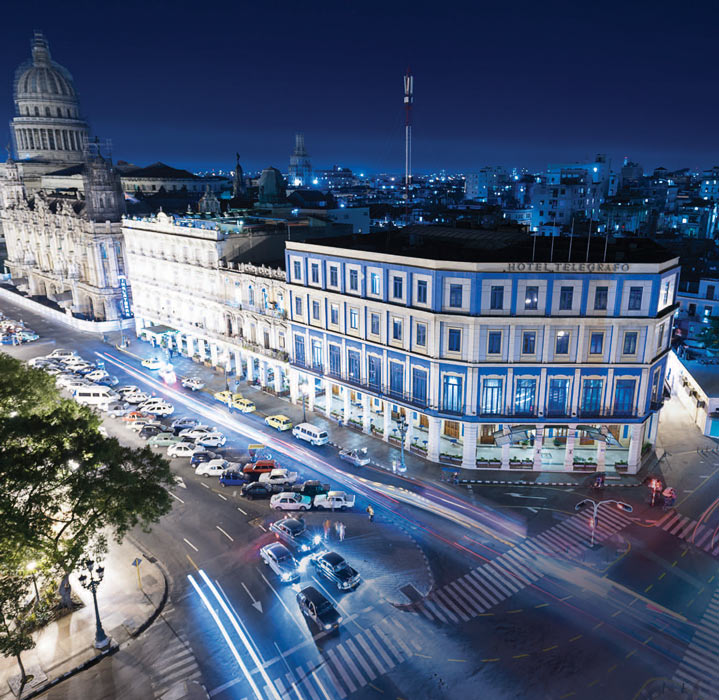
Havana is famous for its architecture and its impressive collection of classic American automobiles from the 1950s and ‘60s. Photo by Matthew Meier.
The Havana Time Warp
Our adventure began in Havana with three days of sightseeing, meetings and educational field-trips learning about Cuba’s history and culture. As we walked the streets of Havana it felt like I had stepped back in time. Classic American cars from the 1950s and early 1960s brought a bygone era to life before our eyes. Men gathered under large shade trees in city squares to discuss sports on a lazy afternoon and locals assembled around games of checkers and dominoes on marble park benches and apartment stoops. This was life as perhaps my parents remembered it, long before I complicated matters.
Havana has a pulse to it that is mesmerizing. I am certain that part of the allure was simply being in a place that, as a U.S. citizen, we had been told our entire lives was forbidden. From the live music coming out of doorways and the Cuban jazz on rooftop bars, to the hustle and bustle of the locals going about their daily lives, there is an energy you can feel. There is also a dichotomy that comes from seeing modern art deco structures next to baroque, intricately carved building facades that are hundreds of years old. Add in fortresses with working cannons, Cuban cigars, rum, exceptional food and friendly people and you have a fantastic melting pot of experiences.
Cuban cuisine is simple, with a mixture of indigenous and European influences, mainly Spanish. Rice and black beans are a staple, along with fried plantains, which is typically served with pork or chicken. Beef and seafood are available at tourist restaurants but is not common for locals. Empanadas filled with meat are also often served as snacks or appetizers. The menu on our live-aboard boat included a variety of local dishes, fresh fruits and vegetables and American-style breakfasts. Fish and local lobster were also readily available.
Homage to Hemingway
An American and Cuban cultural icon, Ernest Hemmingway, lived in Cuba from 1940 to 1960 and is still widely revered. His former home, Finca La Vigia, is now a museum, maintained as it was left upon his departure and his books remain required reading for Cuban school children. The novels, For Whom the Bell Tolls and The Old Man and the Sea were written while Hemmingway was living in Cuba, the latter earning him a Nobel Prize for Literature in 1954. Hemmingway dedicated the award to the citizens of the fishing village of Cojimar, the setting for the story. We toured this village and I was fascinated to see his inspiration in person and realize that the old man was likely based on a real fisherman and drinking buddy of Hemmingway’s.
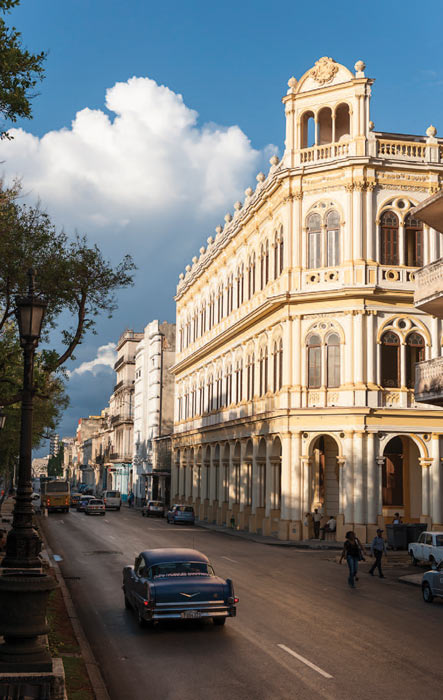
Photo by Matthew Meier.
Cuba’s Own Eden
Our journey from Havana to the Gardens of the Queen began at 4:30 in the morning with a five-hour bus ride through the countryside. Along the way we passed mountains, farms, small towns and miles upon miles of sugar cane, which is used to make Cuban rum. In the fishing village of Jucaro we boarded the boat that would be our home for the next six days and spent another five hours traveling across the Gulf of Ana Maria and the Caribbean Sea to the Gardens of the Queen. The transit provided time to get settled into our rooms, assemble dive gear and camera housings and perhaps grab a short nap to make up for the early wake up call.
The coral reefs in the Gardens of the Queen were the healthiest I have seen in the Caribbean. Everywhere you looked the corals, sea fans and sponges were incredibly robust, in great variety and thriving with fish life. Larger species such as tarpon, barracuda and snapper were a common sight and accompanied the many schools of grunts, tangs and creole wrasse on the reef. The icing on the cake for me was at a dive site called Paradise Reef where we found huge colonies of beautiful, healthy elkhorn coral. These mainly shallow water corals are threatened and endangered throughout their range and in some areas their abundance has declined by 95 percent. It was heartwarming to see them continuing to thrive here.
We were fortunate to have Caribbean Reef Sharks swimming with us on nearly every dive. Rarely have I been in the water with sharks that did not turn and swim in the other direction in reaction to divers, but here they simply continued on their path. The same could be said for the large number of groupers found on the reef. I saw several variations of black grouper, along with tiger grouper and the endangered Nassau grouper. In addition to the reef sharks we had a couple dives where we hung in blue water beneath the boat as a dozen or more silky sharks swam circles around us. The sharks were attracted to the scent of a single fish placed in a steel box beneath the boat and they stayed with us for over an hour providing terrific photo opportunities.
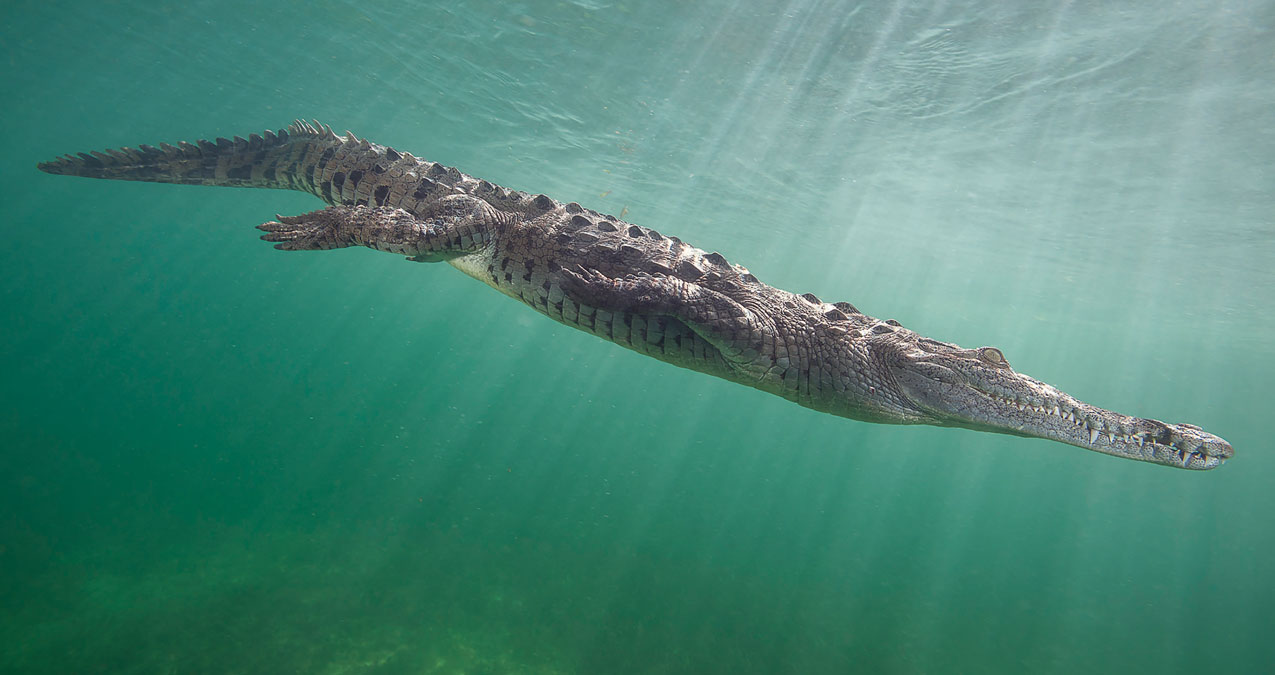
Crocodile encounters are a highlight of many divers’ Cuba trip. Photo by Matthew Meier.
Cuba’s Conservation Efforts
The Gardens of the Queen was Cuba’s first MPA, and its creation required the establishment of fishing licenses and an enforcement office, as well as the creation of jobs and retraining for the displaced fishermen. Many of those fishermen are now employed as sport fishing guides, boat drivers and dive guides within the MPA. The area has been highly successful, as the ecosystem is abounding with healthy corals, large quantities of fish and marine life and abundant apex predators. The evolution took time, yet the fishermen who are still fishing outside the reserve are realizing the benefits of an increased fish catch from the spillover effect and the former fishermen are receiving comparatively higher wages by working in the tourism industry.
The success can be partially attributed to the park being located 50 miles (81 km) offshore, the lack of commercial fishing, limited access and impact and effective enforcement. The Gardens now serves as an example for Cuba and abroad, touting the benefits of conservation and MPAs. Subsequently, the Cuban government has been creating more marine protected areas, with the goal of safeguarding 25 percent of their territorial waters, the most of any country in the world. To that end, efforts are currently underway to expand the fishery reserve and protect the remainder of the Gardens of the Queen as a no take zone.
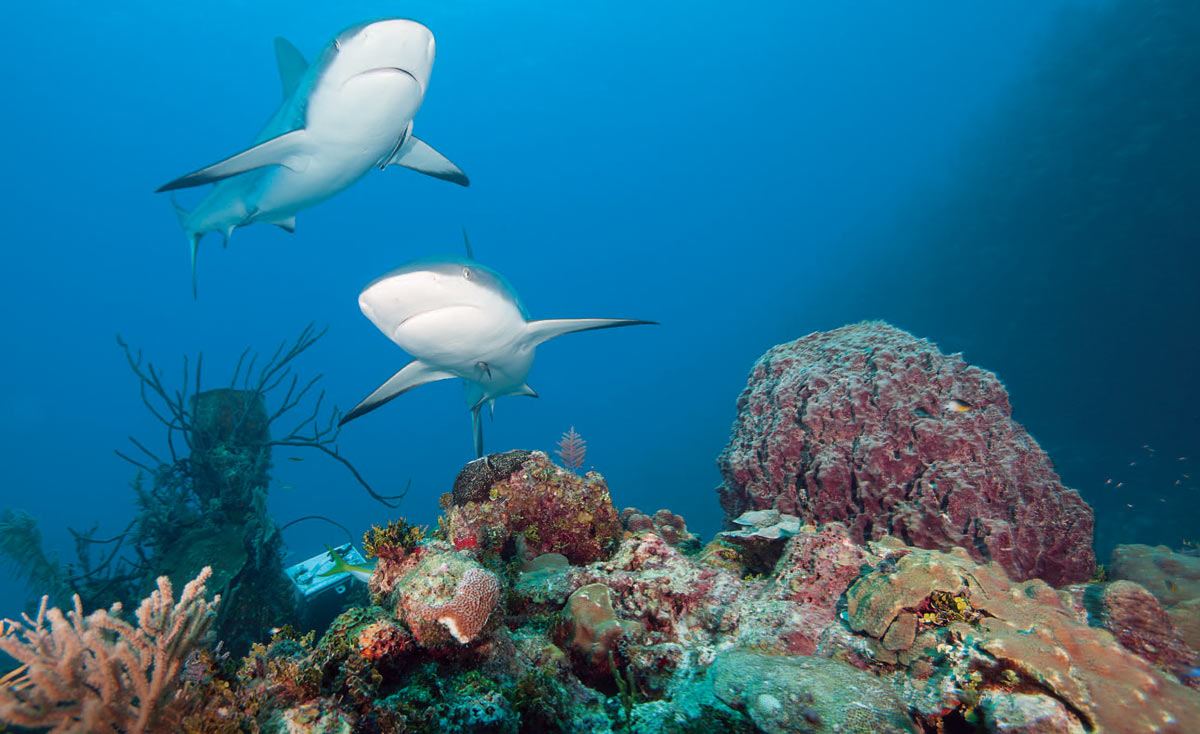
Seeing sharks cruising the reefs is an indication of an intact marine ecosystem. Photo by Matthew Meier.
Diving in Cuba
Diving conditions and visibility at the Gardens of the Queen are dependent on tidal flow. The direction the tide takes the sediment from the mangroves determines which dive sites are best for that time of day. During our visit, we typically had better visibility on our two morning dives and deteriorating visibility in the afternoons. Late afternoon thunderstorms and incredible sunsets were the result of the end of the rainy season. There was also the possibility to see whale sharks on our trip, as they are found in the area around the full moon in October and November but, unfortunately, they did not make an appearance.
On a few of our surface intervals we had the opportunity to snorkel amid the mangroves and surrounding sea grass. I found several species of corals and anemones that I had not seen on the outside reef, along with upside-down jellyfish, sea stars, stingrays and numerous juvenile fishes seeking protection in the mangroves root structure. At one point I was staring face to face with a three-inch-long barracuda, quietly cursing the fact that I did not have a macro lens on the camera.
While the mangroves serve as a nursery for many species of fish, the deserted beaches of these remote islands serve as critical nesting sites for Hawksbill turtles. Thankfully, Cuba no longer harvests turtles as a commercial entity and stopped trying to export Hawksbill turtle products in 2008. We saw a few turtles on our dives and hopefully that means their population is rebounding.
As if the crocodiles, sharks and beautiful reefs were not enough, the Gardens of the Queen also harbors a healthy population of critically endangered Atlantic Goliath grouper. These fish can grow to a length of 8 feet (2.4 m) and are considered mature at a weight of 400 to 800 pounds (181 to 363 kg). We were treated to a couple of fish in the 400-pound range (181 kg), along with a smaller youngster, that was still intimidating in size. These impressive fish are very inquisitive and circled us throughout the dive. On several occasions the larger grouper produced a guttural booming sound to warn the smaller one when it had apparently gotten out of line. The explosive force could be felt in the water column and the concussion sent up a cloud of sand from its gills.
Marine biologists from the University of Havana, along with scientists from abroad, are studying the Gardens of the Queen in hopes of determining why this ecosystem has remained so healthy while other areas around the world have suffered the effects of global warming. With luck, the discoveries made here will help restore other areas to the pristine conditions we experienced on this amazing trip. I look forward to a return visit and highly recommend adding diving in Cuba to your bucket list.






